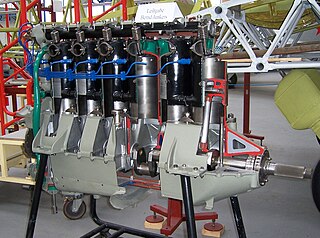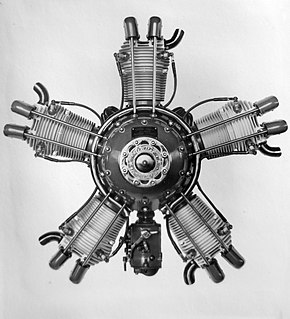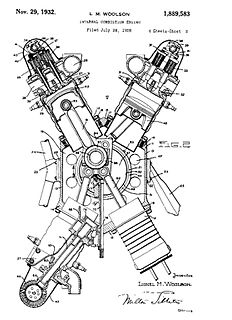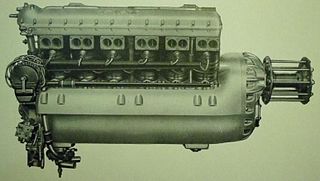Related Research Articles

The Pratt & Whitney R-1690 Hornet was a widely used American aircraft engine. Developed by Pratt & Whitney, 2,944 were produced from 1926 through 1942. It first flew in 1927. It was a single-row, 9-cylinder air-cooled radial design. Displacement was 1,690 cubic inches. It was built under license in Italy as the Fiat A.59. In Germany, the BMW 132 was a developed version of this engine. The R-1860 Hornet B was an enlarged version produced from 1929.
The Klimov M-106 was an experimental liquid-cooled V12 piston aircraft engine intended for Soviet aircraft during World War II.

The Klimov VK-107 was a V-12 liquid-cooled piston aircraft engine used by Soviet aircraft during World War II.

The Delta was a 12-cylinder inverted-V aircraft engine built by Isotta Fraschini prior to and during World War II.

The Fiat A.80 was an 18-cylinder, twin-row, air-cooled, radial aircraft engine produced during World War II. Rated at 1,000 hp (745 kW), it was a more powerful development of the 14-cylinder Fiat A.74.

The Junkers L 5 was a six-cylinder, water-cooled, inline engine for aircraft built in Germany during the 1920s. First run in 1925, it was a much enlarged development of the Junkers L2, in turn a licensed development of the BMW IV.

The BMW VI was a water-cooled V-12 aircraft engine built in Germany in the 1920s. It was one of the most important German aero engines in the years leading up to World War II, with thousands built. It was further developed as the BMW VII and BMW IX, although these saw considerably less use. It was also produced in the Soviet Union as the M-17 and Japan as the Kawasaki Ha-9.

The Walter Venus was a seven-cylinder, air-cooled, radial engine for aircraft use, built in Czechoslovakia in the late 1920s.

The Walter Vega was a five-cylinder, air-cooled, radial engine for aircraft use, built in Czechoslovakia in the late 1920s.

The Fiat A.74 was a two-row, fourteen-cylinder, air-cooled radial engine produced in Italy in the 1930s as a powerplant for aircraft. It was used in some of Italy's most important aircraft of World War II.

The Klimov M-103 is a V12 liquid-cooled piston aircraft engine used by Soviet aircraft during World War II.

The Daimler-Benz DB 602, originally known as Daimler-Benz LOF.6, was a German diesel cycle aero engine designed and built in the early 1930s. It was a liquid-cooled upright V16, and powered the two Hindenburg class airships. It has roughly the same displacement and weight of the Beardmore Tornado, which was used in the ill-fated R101, but has almost twice the power of the Tornado, showing Daimler-Benz's superior knowledge regarding diesel engine construction.
The RAF 3 was a British liquid-cooled, V-12 engine developed for aircraft use during World War I. Based on the eight–cylinder RAF 1 it was designed by the Royal Aircraft Factory but produced by the two British companies of Armstrong Whitworth and Napier & Son. The RAF 7 was a high compression version of the same engine.

The Fiat AS.6 was an unusual Italian 24-cylinder, liquid-cooled V configured aircraft racing engine designed and built in the late-1920s by Fiat especially for the Schneider Trophy air races, but development and running problems meant that it was never able to compete. Although the engine suffered from technical problems, it was later used to set a speed record for piston-powered seaplanes that still stands today.

For the aircraft of the same name, see Fiat AS.2 (aircraft)

The Fiat AS.3 was an Italian 12-cylinder, liquid-cooled V engine designed and built in the mid-1920s by Fiat Aviazione especially for the 1927 Schneider Trophy air race.

The Packard X-2775 was an American experimental liquid-cooled aircraft engine. The engine was constructed as a single crankcase with four banks of six cylinders in what is close to an X-configuration. The engine was an upright 60 degree vee-12 and an inverted 60 degree vee-12 sharing a common crankcase. Although technically incorrect, the engine has been characterized as two Packard 1A-1500 V-12 engines coupled with a mutual crankcase.

The Fiat A.24 was an Italian water-cooled aircraft engine from the 1920s, built in modest numbers. It produced 520 kW (700 hp).

The Fiat A.30 R.A. was an Italian water-cooled aircraft engine from the 1920s, built in large numbers and serving with several air forces up to the beginning of World War II. It produced 447 kW (600 hp).

The Fiat A.22 was an Italian water-cooled aircraft engine from the 1920s. It produced 425 kW (570 hp) and powered several absolute world distance records as well as commercial passenger flights.
References
Notes
Bibliography
- Eves, Edward The Schneider Trophy Story. Shrewsbury. Airlife Publishing Ltd., 2001. ISBN 1-84037-257-5.
- Gunston, Bill. World Encyclopedia of Aero Engines. Cambridge, England. Patrick Stephens Limited, 1989. ISBN 1-85260-163-9
| | This aircraft engine article is missing some (or all) of its specifications. If you have a source, you can help Wikipedia by adding them. |